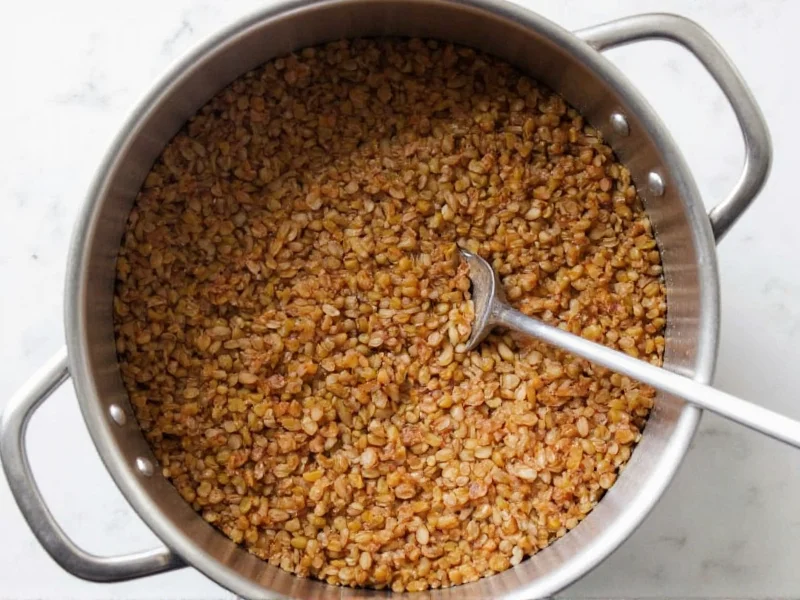Understanding proper lentil preparation can transform your cooking experience from frustrating to flawless. While many dried legumes require lengthy soaking, lentils stand apart due to their smaller size and thinner skins. This comprehensive guide explains exactly how long to soak different lentil varieties for optimal results, backed by culinary science and practical kitchen experience.
Why Soaking Time Matters for Lentils
Unlike larger beans, lentils contain fewer complex sugars that cause digestive discomfort. However, proper preparation still affects texture, cooking time, and nutrient availability. Soaking helps reduce phytic acid, which can interfere with mineral absorption, and may decrease cooking time by up to 25%. The optimal soaking duration varies significantly by lentil type, which explains why many home cooks struggle with inconsistent results.
Lentil Varieties and Their Specific Soaking Requirements
Not all lentils are created equal when it comes to preparation. Understanding these differences is crucial for perfect results every time:
| Lentil Type | Soaking Required? | Optimal Soaking Time | Notes |
|---|---|---|---|
| Green/Brown Lentils | Optional | 2-4 hours | Soaking reduces cooking time by 15-20% and improves texture |
| Red/Yellow Lentils | Not recommended | None | Soaking causes them to become mushy; cook directly |
| Black (Beluga) Lentils | Recommended | 3-4 hours | Maintains distinctive "caviar" texture when properly soaked |
| Puy/French Lentils | Recommended | 1-2 hours | Shorter soak preserves their firm texture |
| Beluga Lentils | Recommended | 2-3 hours | Soaking prevents splitting during cooking |
The Science Behind Lentil Soaking
Soaking initiates a process called autolysis, where natural enzymes begin breaking down complex compounds. For lentils, this primarily affects:
- Phytic acid reduction - Soaking for 2+ hours can decrease phytic acid by 20-30%, improving mineral absorption
- Enzyme activation - Natural enzymes become active, beginning the breakdown of complex starches
- Water absorption - Lentils absorb 1.5-2 times their weight in water during proper soaking
However, over-soaking (beyond 8 hours at room temperature) can lead to fermentation, causing sour flavors and mushy texture. Refrigeration extends the safe soaking window to 24 hours.
Step-by-Step Guide to Proper Lentil Soaking
Follow these professional techniques for consistently perfect lentils:
- Sort and rinse - Remove any debris or damaged lentils, then rinse thoroughly under cold water
- Water ratio - Use 3 parts water to 1 part lentils (they'll expand during soaking)
- Optional acid addition - Adding 1 tablespoon of vinegar or lemon juice per cup of lentils can enhance phytic acid reduction
- Soak duration - Follow variety-specific recommendations (see table above)
- Rinse again - Drain and rinse before cooking to remove surface compounds
Common Mistakes to Avoid
Even experienced cooks make these lentil preparation errors:
- Over-soaking red lentils - These delicate varieties break down quickly, becoming mushy if soaked
- Skipping the rinse after soaking - Removes surface compounds that can cause digestive issues
- Using hot water for soaking - Can cause partial cooking and uneven texture
- Assuming all lentils are the same - Different varieties have distinct soaking requirements
- Adding salt during soaking - Can toughen skins and increase cooking time
When Soaking Isn't Necessary: Quick-Cooking Methods
For time-pressed cooks, these no-soak methods deliver excellent results:
- Quick-soak method - Boil lentils for 2 minutes, then let stand covered for 1 hour before cooking
- Pressure cooking - Most lentils cook perfectly in 8-12 minutes without soaking
- One-pot meals - Add unsoaked lentils directly to soups and stews with extra liquid
Perfecting Your Lentil Cooking Technique
After proper soaking (when needed), follow these cooking tips:
- Use fresh water for cooking, not soaking water
- Add acidic ingredients (tomatoes, vinegar) only after lentils are tender
- Simmer gently - vigorous boiling can cause skins to split
- Check for doneness starting 5 minutes before expected cooking time
- Drain immediately when done to prevent overcooking
Storage Tips for Soaked Lentils
If you've soaked more lentils than needed:
- Store soaked, drained lentils in the refrigerator for up to 24 hours
- Freeze pre-soaked lentils for up to 3 months (thaw before cooking)
- Never leave lentils soaking at room temperature for more than 8 hours
Frequently Asked Questions
Do lentils need to be soaked before cooking?
Most lentils don't require soaking, but certain varieties like Puy and black lentils benefit from a 1-4 hour soak. Red and yellow lentils generally cook best without soaking as they become mushy when soaked.
What happens if I soak lentils too long?
Soaking lentils longer than 8 hours at room temperature can cause fermentation, resulting in sour flavors and mushy texture. If refrigerated, they can safely soak up to 24 hours, but beyond that, quality deteriorates significantly.
Does soaking lentils reduce gas?
Soaking can reduce digestive discomfort by 20-30% by removing some oligosaccharides, but lentils naturally contain fewer gas-producing compounds than larger beans. Rinsing thoroughly after soaking provides the most significant benefit for digestion.
Can I cook lentils without soaking?
Yes, most lentils cook perfectly without soaking. Green and brown lentils may take 5-10 minutes longer to cook, while red and yellow lentils often cook better without soaking as they maintain their texture. Pressure cooking eliminates the need for soaking entirely.
Should I add salt when soaking lentils?
No, adding salt during soaking can actually toughen lentil skins and increase cooking time. It's better to add salt after lentils have become tender during the cooking process for optimal texture and flavor absorption.











 浙公网安备
33010002000092号
浙公网安备
33010002000092号 浙B2-20120091-4
浙B2-20120091-4